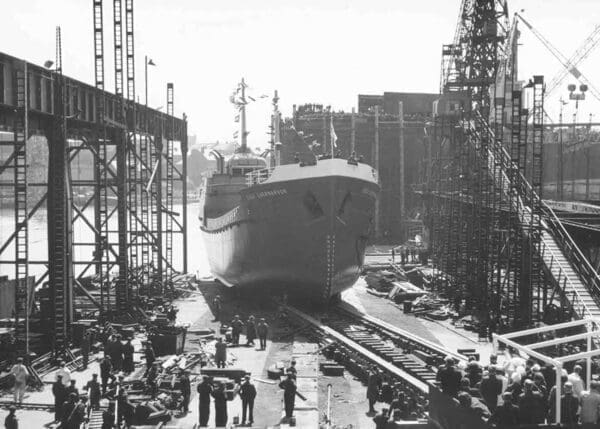01. Shipyard History
History
Naval Station Newport is located in Newport, Rhode Island. The U.S. Navy had been present in Newport prior to this time. Naval Station Newport was established during the Civil War in 1861 when the U.S. Naval Academy was temporarily relocated. Naval Station Newport is still active today.
From the Civil War until after World War II (WWII), Naval Station Newport was the leading site for testing torpedo technology. The Naval Training Station grew in World War I (WWI) with more than 65,000 trainees. This expanded to half a million trainees during WWII.
The U.S. Atlantic Fleet Cruiser-Destroyer Force was based at Naval Station Newport from 1962 until the early 1970s.
Today, the Naval War College is one of the U.S. military’s top institutions. It is home to the Navy, Marine Corps, Coast Guard and U.S. Army Reserves. It is also home to the Naval War College Museum.
Naval Station Newport History at a Glance
- Other Names: NAVASTA Newport, NS Newport
- Location: Newport, Rhode Island
- Owner(s): Federal government
- Years of Operation: 1861 – Present
- Wartime Operations: Revolutionary War, Civil War, World War I (WWI), World War II (WWII) and the Cold War
- Number of Employees: During WWII, more than 500,000 recruits trained in Newport
- Size of Shipyard: 1,339 acres
- Noteworthy Ships: USS John Adams, USS Constitution, USS Grand Canyon, USS Basilone
- Noteworthy Personnel and Trainees: Captain Stephen Bleecker Luce, Admiral Chester Nimitz, Admiral Raymond Spruance, John F. Kennedy
- Types of Ships Built/Serviced: Submarines, cruisers, destroyers
Many workers at Naval Station Newport were potentially exposed to asbestos. Workers’ loved ones may have also experienced secondhand exposure. As a result, many people developed asbestos-related diseases, such as asbestosis, asbestos lung cancer, and pleural and peritoneal mesothelioma. People who developed an asbestos-related disease may be eligible for compensation.
Notable Ships
Naval Station Newport was home to training ships and homeported ships. Many of these ships were built with asbestos components. This put those at the naval station at risk of exposure. One of its notable ships was the USS Grand Canyon.
USS Grand Canyon
The ship tender, USS Grand Canyon, was launched from Todd Shipyard in Washington in 1946. She was homeported at Naval Station Newport for several years.
During her years in service, the USS Grand Canyon participated in the Cold War. She was involved once in 1956 when issues were arising with Egypt and the Suez Canal. The USS Grand Canyon served again in 1962 during the Cuban Missile Crisis. In 1971, she was reclassified from a tender to a repair ship. The USS Grand Canyon was decommissioned in 1978 and sold for scrap.
From the time the USS Grand Canyon’s keel was laid to the time she was scrapped, asbestos was used heavily in shipbuilding, repair and maintenance. Anyone who served aboard her is at risk of developing mesothelioma.
02. Shipyard Asbestos Use
Asbestos Use at Naval Station Newport
Asbestos has properties ideal for building ships. It is highly resistant to heat, fire and physical breakdown. Thus, shipbuilders used asbestos to decrease fire and combustion risks associated with heavy, dangerous equipment.
Naval Station Newport has been active since 1861. During this time, asbestos use was very common. At Naval Station Newport, asbestos was used as insulation in walls, boilers, incinerators and around pipes. As a result, workers came in contact with many products that put them at risk of asbestos-related diseases.
Asbestos Exposure at Naval Station Newport
Civilian workers and military service members worked in shipyards and aboard ships. From the 1930s to the 1980s, tons of asbestos were used in shipyards and shipbuilding. As a result, U.S. Navy veterans and civilian workers at Naval Station Newport faced a high risk of asbestos exposure and developing malignant mesothelioma cancer.
Those who helped maintain or repair submarines, cruisers and destroyers also faced these risks. The heavy use of the dangerous mineral, along with poor ventilation on ships, led to frequent asbestos exposure. For example, insulators were exposed through installation and maintenance work.
Although asbestos use ceased at shipyards by the 1980s, workers and visitors may still risk exposure today. Asbestos materials may still be found on ships built before the 1980s and older equipment at shipyards. Working with asbestos insulation, repairing old boilers and other shipyard duties put individuals at risk of exposure.
03. Asbestos Lawsuits
Asbestos Lawsuits and Settlements
Anyone who was onsite at Naval Station Newport and came in contact with asbestos products is at risk of developing asbestos diseases such as mesothelioma and asbestos cancer. These individuals have many options for compensation.
Asbestos product manufacturers are responsible for exposing people to asbestos. The legal status of these companies can affect what compensation is available to victims. Mesothelioma lawyers can help victims determine if a lawsuit, settlement, VA claim and/or trust fund claim (or a combination of these) is the best compensation option.
Holding Asbestos Companies Responsible
Some companies that wrongfully exposed workers to asbestos are still viable. In other words, they have not filed for bankruptcy. This means individuals can file lawsuits against such companies, which may result in an asbestos settlement or verdict.
For example, AO Smith was a part of the WWII efforts providing materials, gear and water heaters that were manufactured with asbestos.
William Powell Company, another viable company, sold valves with asbestos gaskets and packing to the U.S. Navy beginning in the 1940s. The company did not begin phasing out the use of asbestos until 1986. People who worked with these products were wrongfully exposed to asbestos. Several victims have filed successful lawsuits against these asbestos companies.
04. Filing Asbestos Claims
Asbestos Company Trusts
After exposing many people to asbestos and dealing with the associated mesothelioma claims, more than 100 companies have filed for bankruptcy since the 2000s. As part of their bankruptcy filings, many of these asbestos companies created trust funds to compensate current and future victims of asbestos diseases.
Many Navy veterans, shipyard workers and others have developed asbestos-related illnesses after asbestos exposure on the job. Victims can seek compensation by filing a claim against the responsible asbestos manufacturer’s trust fund.
Asbestos Company Trust Funds and Eligible Years of Employment
The following companies provided asbestos products to Naval Station Newport. After facing many asbestos lawsuits and exposing innocent people to asbestos, these companies filed for bankruptcy and created trusts to pay victims. If an individual worked at Naval Station Newport and developed a disease such as mesothelioma, they may be able to file a claim against these companies’ trusts.
| Asbestos Trust Funds & Eligible Years of Employment | ||
|---|---|---|
| Asbestos Company Name | Eligibility Start Date | Eligibility End Date |
| A.P. Green | 1/1/1962 | 1/2/1968 |
| Armstrong WI Trust | 1/1/1964 | 12/31/1982 |
| Babcock & Wilcox | 1/1/1959 | 12/31/1982 |
| Fibreboard | 1/1/1928 | 12/31/1982 |
| Pittsburgh Corning | 1/1/1971 | 12/31/1982 |
| United States Gypsum | 1/1/1956 | 12/31/1982 |




